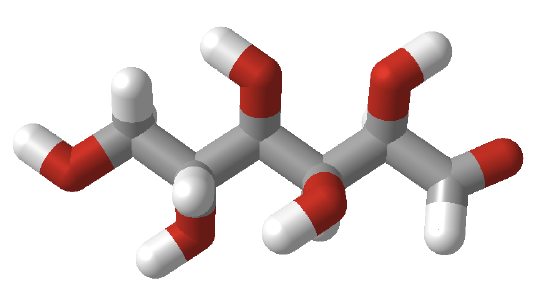7.1: Monosaccharides and Disaccharides
- Page ID
- 14955
Introduction
Carbohydrate or glycan biochemistry is very complex and challenging owing to the stereochemical complexity of simple sugars, a large number of positions on the sugars used to form linkages between other sugars to create polymers, the large number of chemical modifications to base sugars, and the lack of a genetic template to instruct glycan polymer formation. It is no wonder that our understanding of complex glycans has developed after that of the chemically simpler polymers like nucleic acids and proteins.
In addition, the terminology used to describe them varies as well. We use these general descriptions of them:
Sugar: usually refers to low molecular weight carbohydrates like glucose, lactose, and sucrose, but it can also refer broadly to any carbohydrate.
Carbohydrate: a general term that applies to simple sugars to complex sugar polymers like glycogen, starch, and cellulose. The name derives from the formula for simple sugars like glucose (C6H12O6), which can be written as C6(H2O)6 - a carbo (C) - hydrate (H2O).
Glycan: A general term for molecules containing simple sugars and sugar derivatives linked in a polymer, either standalone molecules or attached to other molecules like proteins.
Monosaccharides Structures
The above definition of sugar needs some further nuance. From a chemical perspective, sugars can be defined as polyhydroxy-aldehydes or ketones. The simplest sugars contain at least three carbon atoms, and the most common are the aldo- and keto-trioses, tetroses, pentoses, and hexoses. The 3C sugars are glyceraldehyde and dihydroxyacetone, as shown in Figure \(\PageIndex{1}\).
Figure \(\PageIndex{1}\): Three-carbon sugars
Glucose, an aldohexose, is a central sugar in metabolism. It and other 5C and 6C sugars can cyclize through intramolecular nucleophilic attack of one of the free hydroxyl groups on the carbonyl carbon of the aldehyde or ketone. Such intramolecular reactions occur if stable 5- or 6-member rings can form. The resulting rings are labeled furanose (5-member) or pyranose (6-member) based on their similarity to furan and pyran. On nucleophilic attack to form the ring, the carbonyl O becomes an OH that points either below (α anomer) or above (β anomer) the ring.
Figure \(\PageIndex{2}\) shows different representations of the linear and cyclic forms of the sugars D-glucose, D-ribose, and D-fructose
Monosaccharides in solution exist as equilibrium mixtures of the straight and cyclic forms. In solution, glucose (Glc) is mostly in the pyranose form, fructose is 67% pyranose and 33% furanose, and ribose is 75% furanose and 25% pyranose. However, in polysaccharides, Glc is exclusively pyranose and fructose and ribose are furanoses.
Sugars can be drawn in the straight chain form as either Fischer projections or perspective structural formulas.
In the Fisher projection, the vertical bonds point down into the plane of the paper. That's easy to visualize for 3C sugars but more complicated for larger ones. For those, draw a wedge and dash line drawing of the molecule. When determining the orientation of the OHs on each C, orient the wedge and dash drawing in your mind so that the C atoms adjacent to the one of interest are pointing down. Sighting towards the carbonyl C, if the OH is pointing to the right in the Fisher project, it should be pointing to the right in the wedge and dash drawing, as shown below for D-erythrose and D-glucose. Figure \(\PageIndex{3}\) shows how to convert Fisher projections to wedge dash representations.
Figure \(\PageIndex{4}\) shows an interactive iCn3D model of D-glucose in a linear form.
Orient the molecule as shown in Figure \(\PageIndex{5}\) below, with the carbonyl oxygen pointed to the far right, and compare it to the orientation shown in Figure \(\PageIndex{5}\) to reinforce your understanding of Fisher and wedge/dash projections.

Figure \(\PageIndex{5}\):
Cyclic forms can be drawn either as the Haworth projections, which show the molecule as cyclic and planar with substituents above or below the ring) or the more plausible bent forms (showing glucose in the chair or boat conformations, for example). β-D-glucopyranose is the only aldohexose that can be drawn with all its bulky substituents (OH and CH2OH) in equatorial positions, which probably accounts for its widespread prevalence in nature. Figure \(\PageIndex{6}\) shows four different representations of glucose.
Haworth projections are more realistic than the Fisher projections, but you should be able to draw both structures. Generally, if a substituent points to the right in the Fisher structure, it points down in the Haworth. If it points left, it points up. Generally, the OH on the α-anomer points down (αnts down) while on the β-anomer, it points up (βutterflies up) as illustrated in Figure \(\PageIndex{7}\)
In the Haworth projections, the bulky R group of the next carbon after the carbon whose OH group was the nucleophile for ring formation is pointed up if the OH engaged in the attach was on the right-hand side in the straight chain Fisher diagram (as in α-D-glucopyranose above when the CH2OH group is up). It is pointed down if the OH engaged in the attack was on the left-hand side in the straight chain Fisher diagram (as in α-D-galactofuranose above when the (CHOH)CH2OH group is down). The rest of the OH groups still follow the simple rule that if they point to the right in the Fisher straight chain form, they point down in the Haworth form.
The Fisher structures of most common monosaccharides (other than glyceraldehyde and dihydroxyacetone), which you will encounter most frequently, are shown in Figure \(\PageIndex{8}\).
Figure \(\PageIndex{8}\): Most common monosaccharides discussed in this book
The mirror image of D-Glc is L-Glc. The D- and L- designations refer to the center of asymmetry most remote from the aldehyde or ketone. By convention, all chiral centers are related to D-glyceraldehyde, so sugar isomers related to D-glyceraldehyde at their last asymmetric center are D sugars.
Figure \(\PageIndex{9}\) shows multiple renderings of common hexoses.
Isomers
Sugars can be configurational (interconverted only by breaking covalent bonds) or conformational isomers. Figure \(\PageIndex{10}\) reviews different configurational isomers.
The configurational isomers include enantiomers (stereoisomers that are mirror images of each other), diastereomers (stereoisomers that are not mirror images), epimers (diastereomers that differ at one stereocenter), and anomers (a particular form of stereoisomer, diastereomer, and epimer) shows enantiomers, diastereomers, epimers and anomers of 6 carbon sugars.
Sugars can also exist as conformational isomers, which interchange without breaking covalent bonds. These include chair and boat conformations of the cyclic sugars as shown in Figure \(\PageIndex{12}\).
Monosaccharide Derivatives
Many derivatives of monosaccharides are found in nature. These include
- oxidized forms in which the aldehyde and/or alcohol functional groups are oxidized to carboxylic acids
- phosphorylated forms in which phosphates are transferred from ATP to form phosphoester derivatives
- amine derivatives such as glucosamine or galactosamine
- acetylated amine derivatives such as N-Acetyl-GlcNAc (GlcNAc) or GalNAc
- lactone forms (intramolecular esters) in which an OH group attacks a carbonyl C that was previously oxidized to a carboxylic acid
- condensation products of sugar derivatives with lactate (CH3CHOHCO2-) and pyruvate (CH3COCO2- ), both from the glycolytic pathway, to form muramic acid and neuraminic acids (also called sialic acids), respectively.
Figure \(\PageIndex{13}\) some simple monosaccharide derivatives.
Figure \(\PageIndex{14}\) shows some additional oxidative derivatives of glucose shown in Fischer projections.
Other important derivatives of monosaccharides are sialic acids. N-acetylmuramic acid, found in bacterial cell walls, consists of GlcNAc in ether link at C3 with lactate, while N-acetylneuraminic acid results from an intramolecular cyclization of a condensation product of ManNAc and pyruvate. These sialic acids are shown in Figure \(\PageIndex{15}\).
Sugars are very complicated as the linkages and substituents are so diverse. Figure \(\PageIndex{16}\) show differences in sialic acids between humans and chimps.
What happens when non-vegan humans eat animal products (meat, milk) with N-glycoyl neuraminic acids (Neu5Gc)? Some get incorporated into human membrane glycans. Sialic acids on surface proteins can serve as "receptors" that allow binding of self-cells as well as foreign cells or proteins that have evolved to bind them. A toxin, SubAB, secreted by E. Coli 0157, can bind Neu5Gc. Hence eating meat products can make us more susceptible to bacteria that recognize Neu5Gc.
Formation of Hemiacetals, Acetals, and Disaccharides
Monosaccharides that contain aldehydes can cyclize through an intramolecular nucleophilic attack of an OH at the carbonyl carbon in an addition reaction to form a hemiacetal. In the past the group was called a hemiketal if the attack was on a ketone but now they are also called hemiacetals. On the addition of acid (which protonates the anomeric OH, forming water as a potential leaving group), another alcohol can add, forming an acetal with water leaving. These reactions are shown in Figure \(\PageIndex{17}\).
If the other alcohol is a second monosaccharide, a disaccharide results. The acetal link bonding to the two monosaccharides is called a glycosidic link. If the link between the two sugars involves an anomeric carbon, the newly formed OH group at the link can be designated either as α (if the O on the carbon involved in the glycosidic link is pointing down) or β (if the O is pointing up). For a 2-2 link between hexoses (i.e. between two non-anomeric carbons, the α/β designation is not used. Since sugars contain so many OH groups, which can act as the "second" alcohol in acetal formation, links between sugars can be quite diverse. These include α and β forms of 1-2, 1-3, 1-4, 1-5, 1-6, etc. links. Here are examples of disaccharides:
- maltose: Glc(α 1,4)Glc, which can be considered a disaccharide hydrolysis product of the polysaccharide glycogen or starch (discussed in the section)
- cellobiose: Glc(Glc(α 1,4)Glc 1,4)Glc, which can be considered a disaccharide hydrolysis product of cellulose.
- lactose: Gal(β 1,4)Glc, also known as milk sugar.
- sucrose: Glc(α 1,2)Fru. Since fructose is attached through the anomeric OH of this ketose, the fructose is not in equilibrium with its straight-chain keto form; hence, sucrose is a nonreducing sugar. Note also since the anomeric C-OH or each sugar is used, the α/β designation in the dissacharide is used. Hence sucrose would be abbreviated as Glc(α1,2β)Fru
The differences between lactose and sucrose are illustrated in Figure \(\PageIndex{18}\). Note that the β-D-fructofuranose ring is flipped (left to right as in turning one of your hands over) compared to Figure \(\PageIndex{16}\).
Acetal links between sugars in glycans can be hydrolyzed by water (catalyzed by H+), just as with the other key biological polymers, proteins and nucleic acids.
The disaccharides described above that are linked through a 1,4 linkage are called reducing sugars since they can act as reducing agents in reactions in which they get oxidized. For example, in lactose, since galactose is attached to glucose through the OH on C4, the anomeric glucose carbon, C1, could revert to the noncyclic aldehyde form. This aldehyde is susceptible to oxidation by reagents (Benedict's Solution - with citrate, Fehling's reagent - with tartrate) as these reagents are subsequently reduced. In both reagents, reducing sugars reduce a basic blue solution of CuSO4 (Cu2+) to a brick-red precipitate of \(\ce{Cu2O}\) (Cu+). Sugars (monosaccharides, disaccharides and polysaccharides) that have a potentially open aldehyde at C1 or have an α-hydroxymethyl ketone group which can isomerize to an aldehyde under basic conditions (such as fructose) are called reducing sugars. These oxidizing agents are mild and react with aldehydes and not ketones.
If a monosaccharide, disaccharide, or even polysaccharide has a least one hemiacetal link (for instance the second sugar in lactose), it is a reducing sugar, as the monomer with the cyclic hemiacetal can reversibly open to form an aldehyde. However, if the only links in sugars are full acetals (such as in sucrose when the link is between the two anomeric carbons), the sugar is not reducing.
Alpha-gal syndrome (AGS) is a relatively newly discovered disease caused by the bite of a tick. Tick saliva contains the disaccharide galactose-α-1,3-galactose (alpha-gal). After a tick bite, people develop an immune response to the disaccharide in the form of IgE antibodies. Further bites could cause a mild rash up to an anaphylactic response.
What makes AGS worse is that red meat also contains the disaccharide but is not found in fish, birds, or people. Hence people who mount a strong IgE response to the disaccharide can also elicit the same response when they eat red meat or even if they drink cow's milk, for example. Estimates that up to 450,000 people in the US may develop serious and even life-threatening symptoms after eating red meat.
The structure of Gal(α1,3)Gal is shown in Figure \(\PageIndex{19}\) below.
Figure \(\PageIndex{19}\): The structure of the disaccharide Gal(α1,3)Gal



